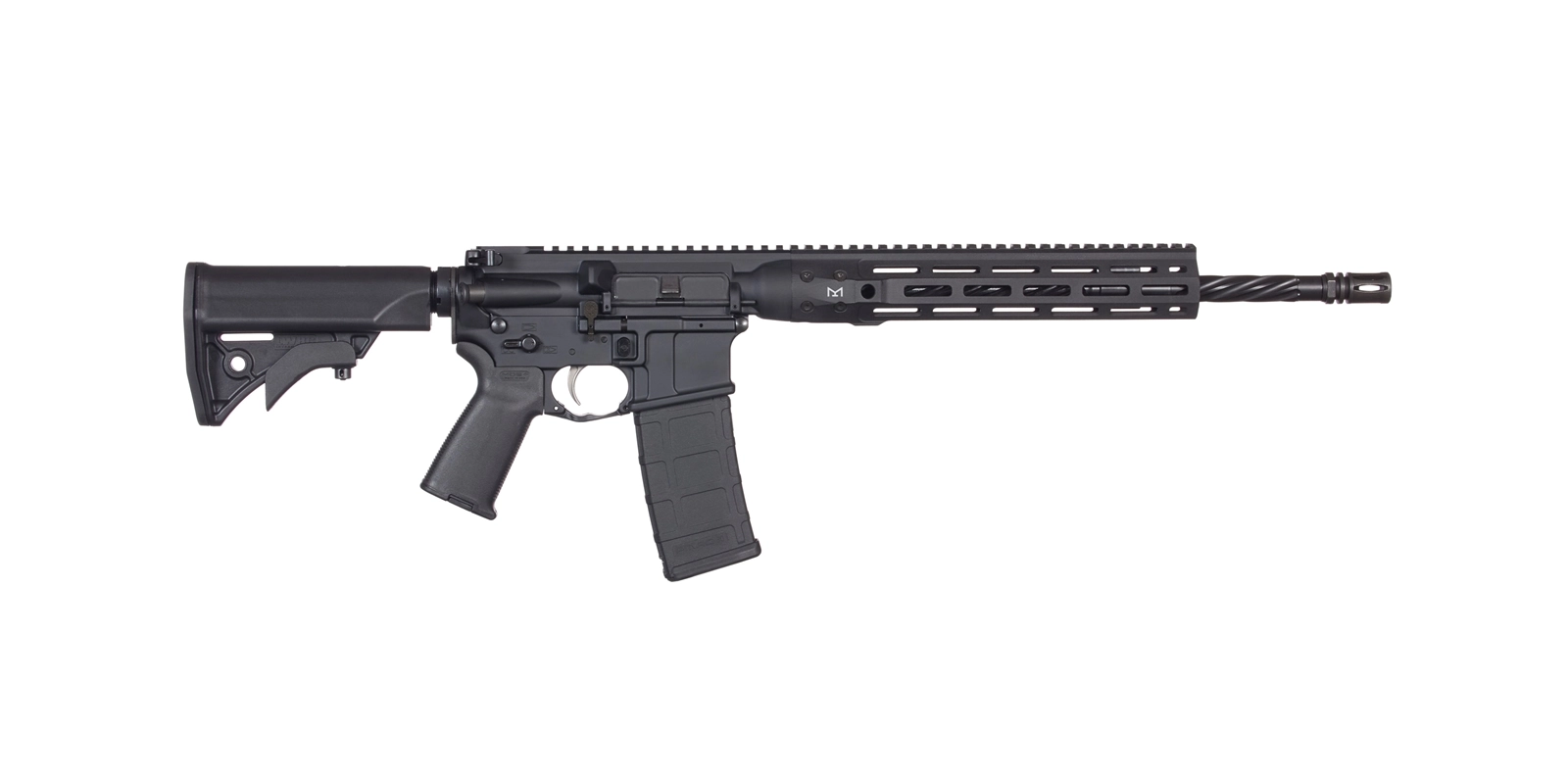Say you walked into our gun shop, or for that matter, any gun shop in the country (in a semi-free state). What is the most common rifle you’d see?
That rifle is likely to be the AR15.
Now, in many gun shops, you’ll probably see all kinds of AR-style rifles in different brands & calibers. Some with different handguards, rail styles, carry handle options, and even different colors. Navigating this extremely saturated market can be a challenge.
We help people daily through this decision-making process and ultimately through their first AR purchase. Since helping a ton of people through this process I thought I’d write my thoughts down and help some people in their researching stage, still trying to figure out the right AR for them.
If there’s one thing that’s true sales, though, it’s that honestly pays. Any professional “salesman” will tell you the same thing. They say, “It’s all about finding a need.” That’s why when selling guns, I try to ask the right questions, find out who my buyer is, and then make solid recommendations after that. I also try to offer some candid advice as well.
The most common situation that I run into on the gun counter is a customer comes in, looking to purchase their first AR15. It could be for a host of different reasons. This customer’s priorities are usually that they want to buy a basic rifle that they can grow with and upgrade over time.
There’s absolutely nothing wrong with doing that. Honestly, that’s what I did. My first AR15 was $850. I had it for two years. Over those two years, that gun changed shape constantly.
At this point, I’ll make a suggestion to the customer. This suggestion goes a little like this:
Instead of spending $900~ dollars on getting a basic, budget-friendly AR, why not pay a bit more and get something out of the box upgraded.
This is what I wish I had done instead of buying my $850 rifle years ago.
The reason why? Because after a year or two of constantly changing parts on my AR, I realized that I had about $3000 invested in parts and labor on the gun. I could have gotten a rifle I really liked out of the box and spent nothing on extra parts with that money. Honestly, I may even have saved money.
So, out of the box upgraded, what rifle fits that bill?
Well, for me, it’s the LWRC IC-DI MLOK” Rifle that we have in the shop for $1599. (Find it here)

There are a few different reasons why I recommend this rifle. First, let me tell you about LWRC as a company, then we’ll get into the details.
LWRC is a firearms manufacturing company based out of Cambridge, Maryland. As a kid, I first heard of them watching FutureWeapons on the discovery channel.
Many in the firearms industry recognize LWRC for their piston-driven AR15s. This simply means that they’ve switched the gas system that is typically used on an AR platform rifle (called direct impingement, where the excess gas used from firing the gun is used to cycle the bolt)
So, why this rifle?
First off, it’s a fully ambidextrous rifle, meaning you can lock the bolt open and release the magazine regardless of if you’re shooting left or right-handed. This is more than just a quality-of-life feature. Shooting from difficult positions like around cover or underneath a car might require that you use your non-dominant hand to make a shot or reload. It’s also uncommon to have a fully ambi lower; only a few companies make them, LWRC being one of them.
This ambidextrous nature extends to the rifle’s safety selector and charging handle.
The trigger is an LWRC enhanced fire control group. The trigger will be a bit smoother than a mil-spec trigger, and it’s also nickel-boron coated.
The barrel is a cold hammer-forged and spiral fluted in-house. One of the biggest reasons this is a great option specifically here in Maryland is that regardless of the fluting of the barrel, this gun still is Maryland compliant. Maryland requires that all AR15 rifles in the state have a heavy barrel profile, sometimes referred to as HBAR. LWRC being a Maryland company, is complying with that regulation and yet lightening the barrel by spiral fluting it.
Additionally, that same spiral fluting has some benefits: it can extend the life of the barrel over heavy firing schedules. How is this possible, you might ask? A spiral fluted barrel has more surface area than your average run-of-the-mill barrel. This means that the barrel will heat slower. This also means that the gun will remain accurate for longer because accuracy decreases as a gun gets hot.
The rail itself is an MLOK rail. This is pretty ubiquitous nowadays, and most companies are making accessories for rifles with an MLOK mount. This system allows the rail to be lightweight but still extremely strong. The rail itself is held in by 12 screws, so it’s not going anywhere. An additional benefit is that the machining makes the gun tight and flows together nicely. Companies who produce rifles that are an amalgamation of parts sometimes have noticeable splits and gaps where their uppers meet the handguard. Not here with LWRC.
Underneath the rail, we have our low-profile gas block and gas tube; LWRC is famous for their piston guns, and for those that are willing to drop the extra cash on them, they’re well worth it. But for this example, we’re looking at the direct impingement model.
Inside the chamber, we have LWRC’s extremely innovative nickel-boron bolt carrier group. This nickel-boron coating improves durability and makes it, so you spend less time cleaning your rifle and longer shooting. What makes it stand out from all other bolt carriers on the market is that it is a one-piece design. There’s no need for screws to hold the gas key in place because it’s machined into the BCG. This design makes the bolt carrier stronger and leads to better quality control. On a traditional BCG, those screws represent possible failure points or gas leaks, leading to a possibly unreliable rifle. With this innovative BCG, LWRC ensures that your rifle will run great every time.
As far as all the small parts, LWRC only uses top-tier components in the build process for the guns, and most of the components are machined in-house.
The stock is LWRC’s proprietary compact adjustable stock, which in my opinion, is the best of both worlds between a VLTOR and B5 Systems stock.
Additionally, LWRC’s piston rifles and government direct impingement rifles have their highly innovative QD endplate. This endplate completely eliminates the need to manually stake the castle nut. For those unfamiliar, castle-nut staking means that you make a small indent in the castle nut, so it doesn’t come loose. LWRC’s QD endplate utilizes a hex key at the bottom that, when twisted, raises a spike into the castle nut, staking it. This QD endplate from LWRC allows the endplate to be removed easily if need be.
The grip is LWRC’s proprietary ULTRA Combat Grip. The angle is similar to a Magpul more grip, but with different texturing, which LWRC calls “over-molded snakeskin texturing” It’s pretty comfortable in my experience and does the job. What more can you really say about a grip? It features an internal storage compartment to house a CR123 battery, a sight adjustment tool & an Allen wrench.
Finally, LWRC has excellent quality controls. We’ve had hundreds of these rifles shipped to us, and not one has ever been sent back for even small stuff like “mushy” mag releases or stiff safety selectors.
With all of that innovation and quality packed into a rifle that for the quality is extremely competitively priced, how could you go wrong!
We here at TMGN stand by the quality produced by our friends over the Chesapeake Bay bridge at LWRC and are proud to be a dealer! We feel that for the money, LWRC is one of the best AR15s that you can get on the market today. If you don’t believe me, I implore you to come by the shop and see for yourself.



